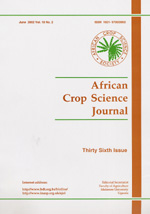
|
African Crop Science Journal
African Crop Science Society
ISSN: 1021-9730
EISSN: 1021-9730
Vol. 28, No. 4, 2020, pp. 517-527
|
 Bioline Code: cs20059
Bioline Code: cs20059
Full paper language: English
Document type: Research Article
Document available free of charge
|
|
|
African Crop Science Journal, Vol. 28, No. 4, 2020, pp. 517-527
| en |
Phenotypic variability and correlation estimates for traits of Burkina Faso’ sweet grain sorghum genotypes
Sawadogo, N.; Naoura, G.; Ouedraogo, M.H.; Tonde, M.; Tiendrebeogo, J.; Tiendrebeogo, K.F.; Bougma, L.A.; Tiama, D. & Zongo, J.-D.
Abstract
Sweet grain sorghum [ Sorghum bicolor

(L.) Moench] is a neglected crop mainly grown for its sweet grains in the pasty form. Although its taste is the main character of interest, knowledge of protein related content of the grain, especially when linked to its value for infant porridge appears equally important. The objective of this study was to evaluate the status of crude protein content of pasty grains and to determine genetic correlations between morphological and biochemical traits among sweet grain of sorghum genotypes in Burkina Faso. Eight sweet grain sorghum cultivars (BTO2, BZI1, KBZ4, PBO5, PGO3, SBR7, SPI2, STO4) were evaluated through 13 morphological and two biochemical variables. Crude protein content of these genotypes was also compared with the composition of two controls of sweet stalk sorghum (ETS) and ordinary grain sorghum or common sorghum (EBS). The analysis of variance revealed variability within sweet grain sorghum accessions, mainly on the biochemical traits (crude protein and water content) and two morphological traits (peduncle and panicle lengths), which discriminated significantly in the thresholds of 1 and 5%, respectively. In addition, sweet grain sorghum had low crude protein content compared to other types of sorghum, except, two genotypes of sweet grain sorghum (BZI1 and STO4) which recorded higher protein content compared to the common sorghum. An important and negative correlation was noted between sowing-flowering cycle and protein content.
Keywords
Crude protein; Sorghum bicolor; sweet stalk sorghum
|
| |
| fr |
Sawadogo, N.; Naoura, G.; Ouedraogo, M.H.; Tonde, M.; Tiendrebeogo, J.; Tiendrebeogo, K.F.; Bougma, L.A.; Tiama, D. & Zongo, J.-D.
Résumé
Le sorgho grains sucrés [ Sorghum bicolor

(L.) Moench] est une culture négligée produite essentiellement pour ses grains sucrés au stade pâteux. Bien que la saveur sucrée du grain soit le principal caractère d’intérêt, une connaissance de la teneur en protéines totales du grain au stade pâteux pourrait favoriser son utilisation pour implémenter les bouillies infantiles et contribuer à sa meilleure valorisation. La présente étude vise donc à déterminer la teneur en protéines totales des grains au stade pâteux du sorgho grains sucrés et établir les corrélations génétiques entre les caractères morphologiques et biochimiques. Ainsi, huit génotypes de sorgho grains sucrés (BTO2, BZI1, KBZ4, PBO5, PGO3, SBR7, SPI2, STO4) ont été évalués à l’aide de 13 caractères morphologiques et deux caractères biochimiques. La teneur en protéines totales de ces génotypes a été ensuite comparée à celle de deux témoins dont un sorgho à tige sucrée (ETS) et un sorgho ordinaire (ESB). L’analyse de variance a révélé une variabilité au sein des cultivars de sorgho grains sucrés observée surtout au niveau des traits biochimiques (teneur en protéines totales des graines et teneur en eau des graines) et de deux traits morphologiques (longueur du pédoncule et longueur de la panicule) qui ont significativement discriminé les accessions aux seuils de 1 et 5%, respectivement. De plus, le sorgho grains sucrés a présenté une faible teneur en protéines totales comparativement aux autres types de sorgho à l’exception de deux génotypes (BZI1 et STO4) qui ont montré une teneur en protéines plus élevée que le sorgho ordinaire. Une forte corrélation significative et négative a été également notée entre le cycle semis-floraison et la teneur en protéines totales.
Mots Clés
Protéines totales; Sorghum bicolor; sorgho à tige sucrée
|
| |
© Copyright 2020 - African Crop Science Society
|
|
